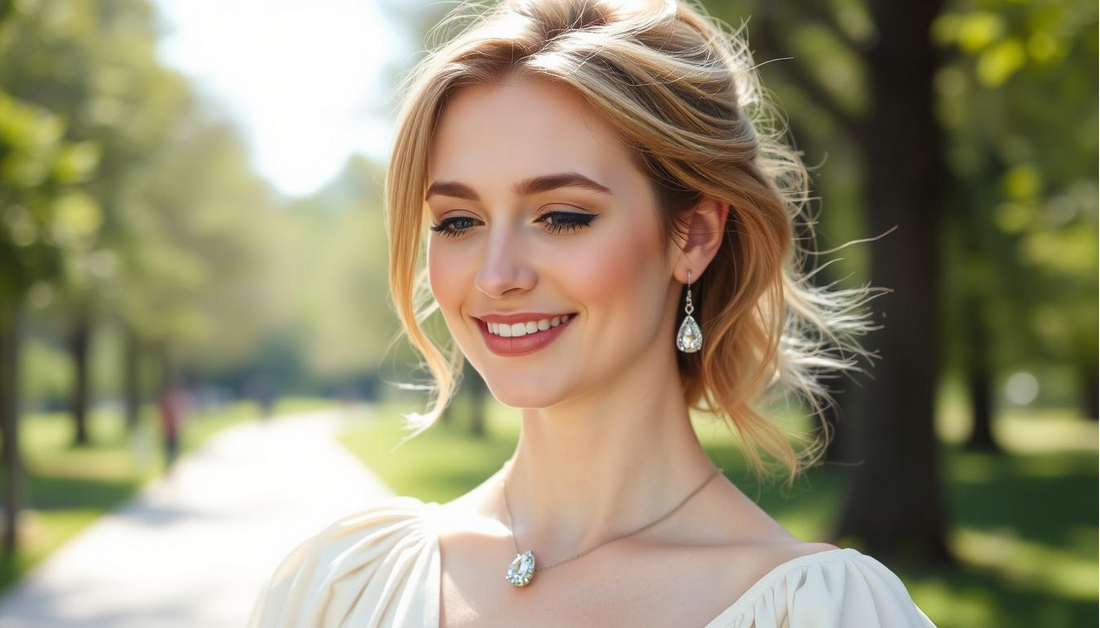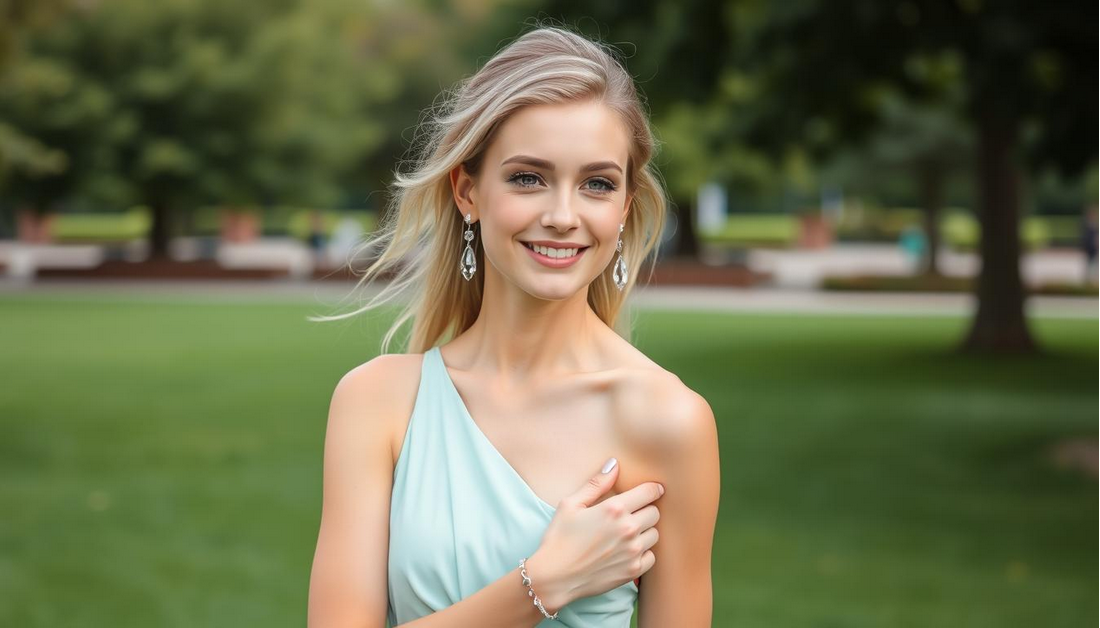India customers to view on amazon.in
Diamond Shapes: One Style, Endless Sparkle
The world of diamond jewelry is vast and varied, with numerous jewelry cuts available to suit different tastes and preferences. At the heart of this diversity lies the captivating allure of diamond shapes, each offering a unique way to experience the beauty of diamond cuts.
- The Fascinating World of Diamond Shapes
- Diamond Shapes: One Style, Endless Sparkle
- Round Brilliant: The Timeless Classic
- Princess Cut: Modern Elegance
- Oval and Pear: Elongated Beauty
- How Oval Diamonds Create the Illusion of Longer Fingers
- Avoiding the “Bow-Tie Effect” in Oval Cuts
- The Unique Appeal of Pear-Shaped Diamonds
- Emerald and Asscher: Vintage Sophistication
- The Step-Cut Difference: Hall of Mirrors Effect
- Clarity Considerations for Step-Cut Diamonds
- Art Deco Inspiration in Modern Settings
- Cushion, Radiant, and Marquise: Distinctive Choices
- The Soft Appeal of Cushion Cut Diamonds
- Radiant Cut: Combining the Best of Princess and Round
- Making a Statement with Marquise Diamonds
- Heart and Trillion: Unconventional Brilliance
- Symbolism and Romance of Heart-Shaped Diamonds
- The Unique Geometry and Challenges of Trillion Cut
- Setting Options for Unusual Diamond Shapes
- Comparing Diamond Shapes: Making the Right Choice
- Diamond Shape Meanings and Personality
- What Your Diamond Shape Says About Your Style
- Cultural and Historical Significance of Different Cuts
- Matching Diamond Shapes to Occasions
- How to Choose the Perfect Diamond Shape
- Matching Shape to Hand Size and Finger Length
- Practical Considerations for Different Lifestyles
- Budget Implications of Various Shapes
- Diamond Shape Trends for 2025 and Beyond
- Revival of Vintage Cuts in Modern Settings
- Celebrity Influences on Diamond Shape Popularity
- Emerging Trends in Fancy Colored Diamond Shapes
- Conclusion: Finding Your Perfect Diamond Shape
- FAQ
- What is the most popular diamond shape?
- How do different diamond shapes affect the perceived size of the diamond?
- What is the difference between brilliant cut and step cut diamonds?
- Are certain diamond shapes more suitable for specific settings or metals?
- How do I choose the right diamond shape for my engagement ring?
- What are the current trends in diamond shapes for 2025?
- How does the cut of a diamond affect its price?
- What are the durability considerations for different diamond shapes?

From classic round brilliants to more intricate fancy shapes, the array of diamond shapes is truly breathtaking. Whether you’re drawn to the simplicity of a solitaire setting or the complexity of a multi-faceted design, there’s a one style that suits your individuality, radiating an endless sparkle that captivates onlookers.
Key Takeaways
- Various diamond shapes offer unique sparkle and beauty.
- Diamond cuts play a crucial role in determining the overall appearance.
- Jewelry cuts can significantly impact the diamond’s brilliance.
- Different diamond shapes suit different tastes and preferences.
- The right diamond shape can enhance the overall aesthetic of the jewelry piece.
The Fascinating World of Diamond Shapes
The world of diamond shapes is a fascinating realm that combines artistry and precision. Diamond shapes have become an integral part of jewelry, offering a wide range of choices for consumers.

What Makes Diamond Shapes Special
Diamond shapes are special because they are a result of expert cutting techniques that bring out the best in the diamond. The shape of a diamond can greatly affect its brilliance and fire. Different shapes cater to various tastes and preferences, making each diamond unique.
How Diamond Cutting Evolved Through History
The history of diamond cutting dates back centuries, with techniques evolving over time. From the early table cuts to modern brilliant cuts, the art of diamond cutting has become more sophisticated. Understanding the evolution of diamond cutting helps appreciate the craftsmanship behind different diamond shapes.
Diamond Shapes: One Style, Endless Sparkle
A diamond’s sparkle is not just a product of its shape, but a complex interplay of light and cut. The way a diamond is cut can significantly affect its ability to refract light, creating a dazzling display of brilliance and fire.
The Science Behind the Sparkle
The sparkle of a diamond is a result of its internal structure and the precision of its cut. Diamonds are made up of pure carbon, crystallized in a unique structure that refracts light. When light enters a diamond, it is refracted and dispersed, creating a spectrum of colors.
How Cut Affects Light Performance
The cut of a diamond is crucial in determining its light performance. A well-cut diamond will refract light better, appearing more brilliant and fiery. The proportions, symmetry, and polish of a diamond all contribute to its overall sparkle.
Brilliance, Fire, and Scintillation Explained
Brilliance refers to the bright, shiny appearance of a diamond. Fire is the dispersion of light into its spectral colors. Scintillation is the sparkle and flashes of light a diamond produces when it moves. Together, these elements create a diamond’s unique sparkle.

“A well-cut diamond is a symphony of light and fire, a true marvel of nature and craftsmanship.”
Understanding the science behind a diamond’s sparkle can enhance one’s appreciation for the intricate craftsmanship involved in diamond cutting.
Round Brilliant: The Timeless Classic
When it comes to diamond cuts, the round brilliant is often considered the gold standard, offering unparalleled light performance. This cut has been a favorite among jewelers and consumers alike for its ability to maximize brilliance and fire.
Why Round Diamonds Remain the Most Popular Choice
Round diamonds continue to dominate the market due to their exceptional sparkle and versatility in various settings. Their popularity can be attributed to their ability to complement a wide range of jewelry styles, from classic solitaire engagement rings to more intricate halo settings.
Ideal Proportions for Maximum Brilliance
A round brilliant diamond’s brilliance is heavily dependent on its proportions. The ideal proportions include a table size between 53% and 58%, a depth between 59% and 63%, and a crown angle between 33° and 36°. These proportions work together to optimize the diamond’s light performance.
Setting Styles That Complement Round Diamonds
The setting style can significantly impact the overall appearance of a round diamond. Popular setting styles include:
- Solitaire settings, which emphasize the diamond’s beauty
- Halo settings, which add extra sparkle and protection
- Pavé settings, which create a dazzling band of diamonds
Here’s a comparison of different setting styles for round diamonds:
| Setting Style | Description | Advantages |
|---|---|---|
| Solitaire | A simple setting featuring a single diamond | Emphasizes the diamond’s beauty, minimalist design |
| Halo | A setting surrounded by smaller diamonds | Adds extra sparkle, provides protection to the center diamond |
| Pavé | A setting featuring small diamonds set closely together | Creates a dazzling band of diamonds, adds texture and interest |

Princess Cut: Modern Elegance
The Princess Cut diamond is a modern interpretation of elegance in diamond jewelry. Its square or rectangular shape and brilliant facets give it a unique sparkle that appeals to those looking for a contemporary twist on traditional diamond shapes.
The Appeal of Square Diamonds
Square diamonds, like the Princess Cut, offer a distinctive look that sets them apart from more traditional round diamonds. Their angular shape can make the diamond appear larger and gives the setting a modern, sleek appearance. The Princess Cut’s facets are designed to maximize brilliance, making it a popular choice for those who value sparkle.

Protecting the Vulnerable Corners
One of the considerations with Princess Cut diamonds is protecting their vulnerable corners. These corners can be prone to chipping, so it’s essential to choose a setting that offers protection. A setting with a robust bezel or prongs that cover the corners can help safeguard the diamond.
Best Metal Choices for Princess Cut Settings
The choice of metal for a Princess Cut diamond setting can significantly impact its overall appearance. White gold and platinum are popular choices as they complement the diamond’s sparkle. Here’s a comparison of different metals:
| Metal | Durability | Appearance |
|---|---|---|
| White Gold | High | Modern, sleek |
| Platinum | Very High | Luxurious, durable |
| Yellow Gold | High | Classic, warm |
Choosing the right metal depends on personal preference and lifestyle. For instance, platinum is known for its durability and is a good choice for those with active lifestyles.
Oval and Pear: Elongated Beauty
For those seeking a diamond that combines elegance with a touch of uniqueness, oval and pear shapes are excellent choices. These elongated diamond shapes not only offer a sophisticated alternative to traditional round diamonds but also provide a unique aesthetic that can enhance the beauty of the wearer’s hand.
How Oval Diamonds Create the Illusion of Longer Fingers
Oval diamonds are renowned for their ability to create the illusion of longer fingers. This is due to their elongated shape, which draws the eye along the length of the finger, creating a slimming effect. According to a study by the Gemological Institute of America (GIA), the elongated shape of oval diamonds can make fingers appear up to 10% longer.
Avoiding the “Bow-Tie Effect” in Oval Cuts
One of the challenges with oval diamonds is avoiding the “bow-tie effect,” a dark area that can appear across the center of the diamond due to its cut. To minimize this effect, it’s crucial to select an oval diamond with excellent symmetry and a well-proportioned cut. Experts recommend choosing oval diamonds with a length-to-width ratio between 1.3 and 1.5 to achieve optimal brilliance.
“The key to a beautiful oval diamond is not just its proportions, but also how it is cut to maximize brilliance and fire.” –
GIA Diamond Expert
The Unique Appeal of Pear-Shaped Diamonds
Pear-shaped diamonds, also known as teardrop diamonds, offer a unique blend of the round brilliant and marquise shapes. Their distinctive shape makes them a standout choice for those looking for a diamond that is both elegant and distinctive. Pear-shaped diamonds are particularly versatile, suiting a variety of settings and styles.
| Diamond Shape | Length-to-Width Ratio | Brilliance |
|---|---|---|
| Oval | 1.3-1.5 | Excellent |
| Pear | 1.5-1.7 | Very Good |
Styling Tips for Pear Diamond Rings
When it comes to styling pear diamond rings, there are several approaches to consider. For a classic look, a solitaire setting can highlight the diamond’s unique shape. For a more modern appearance, consider a halo setting or a bezel setting that complements the teardrop shape. Ultimately, the styling choice depends on personal preference and the desired aesthetic.
- Pair pear diamond rings with minimalist bands for a sleek, modern look.
- Consider a vintage-inspired setting to add a touch of elegance.
- For a bold statement, mix the pear diamond with other shapes or stones.
Emerald and Asscher: Vintage Sophistication
Emerald and Asscher cut diamonds are celebrated for their geometric precision and the elegant ‘hall of mirrors’ effect they produce. These step-cut diamonds have a unique allure that sets them apart from more traditional brilliant cuts.

The Step-Cut Difference: Hall of Mirrors Effect
The step-cut faceting style of emerald and Asscher diamonds creates a distinctive “hall of mirrors” effect. This is characterized by a series of rectangular facets that resemble the steps of a staircase, hence the name “step-cut.” The large, flat facets produce a unique optical effect that emphasizes the diamond’s clarity rather than its brilliance.
“The step-cut is a testament to the artistry of diamond cutting,” notes a renowned gemologist. “It requires precision and an understanding of how light interacts with the diamond’s geometry.”
Clarity Considerations for Step-Cut Diamonds
Clarity is particularly important for step-cut diamonds like emerald and Asscher cuts. Because these diamonds have larger facets and fewer overall facets than brilliant cuts, inclusions are more visible. Therefore, it’s crucial to select a diamond with high clarity to maximize its beauty.
- Look for diamonds with clarity grades of VS1 or higher.
- Consider the type and position of inclusions.
- Opt for a diamond with a certificate from a reputable gemological laboratory.
Art Deco Inspiration in Modern Settings
The geometric patterns and clean lines of emerald and Asscher cuts evoke the glamour of the Art Deco era. Modern jewelers often draw inspiration from this period, combining vintage style with contemporary settings to create unique pieces.
As Forbes notes, “Art Deco jewelry is characterized by its use of geometric shapes, bold colors, and luxurious materials, making it a perfect match for the sophisticated look of emerald and Asscher cut diamonds.”
By understanding the characteristics and appeal of emerald and Asscher cuts, you can make an informed decision when choosing a diamond that reflects your personal style and sophistication.
Cushion, Radiant, and Marquise: Distinctive Choices
For those seeking a diamond that’s a step beyond the traditional round brilliant, cushion, radiant, and marquise cuts offer distinctive beauty and character. These unique diamond shapes have gained popularity for their ability to add a personal touch to jewelry pieces.

The Soft Appeal of Cushion Cut Diamonds
Cushion cut diamonds are known for their soft, romantic appearance. The cushion cut features larger facets, which give it a unique sparkle and a vintage charm. This cut is particularly appealing to those who appreciate antique jewelry or are looking for a diamond that stands out from the more modern brilliant cuts.
- Soft, romantic appearance
- Larger facets for unique sparkle
- Vintage charm
Radiant Cut: Combining the Best of Princess and Round
The radiant cut diamond combines the elegance of the emerald cut with the brilliance of the round cut. Its trimmed corners make it more durable, while its stepped faceting and brilliant faceting create a captivating display of light. This cut is ideal for those who want a diamond that offers both sophistication and brilliance.
- Combines elegance and brilliance
- Trimmed corners for durability
- Unique faceting for captivating light display
Making a Statement with Marquise Diamonds
Marquise diamonds are known for their elongated shape, which can make the finger appear longer and more slender. This cut is a statement piece for those who want a diamond that’s both elegant and distinctive.
Historical Significance of the Marquise Cut
The marquise cut has a rich history, dating back to the 18th century when it was allegedly created to resemble the smile of King Louis XV’s mistress, Madame de Pompadour. Its unique shape has made it a favorite among royalty and continues to be a symbol of elegance and sophistication.
Heart and Trillion: Unconventional Brilliance
For those seeking a diamond that stands out from the crowd, heart-shaped and trillion cut diamonds offer a unique blend of romance and unconventional brilliance. These distinctive shapes are not only visually striking but also carry deep symbolic meanings, making them a compelling choice for those looking for something beyond the traditional round brilliant diamond.
Symbolism and Romance of Heart-Shaped Diamonds
Heart-shaped diamonds are often associated with love and romance, making them a popular choice for engagement rings and anniversary gifts. The heart shape is a universal symbol of affection, and when paired with the eternal beauty of a diamond, it creates a powerful and emotional piece of jewelry. As Harry Winston once noted, “A diamond is a symbol of love, and a heart-shaped diamond is a symbol of love that’s even more profound.”

The Unique Geometry and Challenges of Trillion Cut
The trillion cut diamond, with its triangular shape and typically 31 or 44 facets, presents a unique geometric challenge for cutters. The precision required to maximize brilliance and fire in a trillion cut is considerable, as the shape can easily appear dull if not cut correctly. However, when done well, the trillion cut offers a mesmerizing display of light and brilliance.
| Diamond Shape | Number of Facets | Brilliance Level |
|---|---|---|
| Trillion Cut | 31 or 44 | High |
| Heart-Shaped | Varies | High |
Setting Options for Unusual Diamond Shapes
Setting heart-shaped or trillion cut diamonds requires careful consideration to enhance their unique beauty. For heart-shaped diamonds, a bezel setting can protect the vulnerable edges, while a solitaire setting can maximize the visibility of the diamond’s shape. Trillion cuts, with their angular geometry, can be paired with baguette or step-cut diamonds to create a striking contrast. As designer Jean Dousset suggests, “The right setting can elevate an unusual diamond shape, turning it into a true masterpiece.”
“The art of diamond cutting is not just about precision; it’s about understanding the emotional resonance of the stone.”
Christopher Slowinski, Master Diamond Cutter
Comparing Diamond Shapes: Making the Right Choice
Diamond shapes are not just about aesthetics; they also impact the stone’s perceived size, price, and durability. When choosing a diamond, it’s essential to consider these factors to make an informed decision that suits your needs and preferences.
Shape vs. Size
The cut of a diamond significantly affects its perceived carat weight. For instance, oval and marquise diamonds often appear larger than round diamonds of the same carat weight due to their elongated shape. In contrast, Asscher and emerald cuts may appear smaller because they have a larger table size and less depth.
Price Differences
Price variations between diamond shapes are influenced by demand, cutting waste, and market trends. Round brilliant diamonds, being the most popular, tend to be more expensive. Fancy shapes like heart or trillion cuts might be more affordable due to lower demand or more efficient cutting processes.

Durability Considerations
Different diamond shapes have varying levels of durability. Round and cushion cuts are generally more forgiving due to their rounded edges, while princess and Asscher cuts have more vulnerable corners that require careful handling and setting to prevent damage.
When comparing diamond shapes, consider the following key factors:
- The impact of shape on perceived size
- Price differences influenced by market demand
- Durability considerations based on the diamond’s cut and setting
By weighing these factors, you can choose a diamond shape that not only sparkles beautifully but also meets your practical needs.
Diamond Shape Meanings and Personality
Beyond their beauty, diamond shapes carry meanings that can resonate with your individuality. The choice of diamond shape can be a reflection of personal style, cultural background, and even the occasion it’s meant for.
What Your Diamond Shape Says About Your Style
Different diamond shapes are often associated with distinct personalities. For instance, a round brilliant diamond is seen as classic and timeless, reflecting a traditional yet elegant style. On the other hand, a princess cut diamond with its sharp edges and modern look may signify a bold and contemporary personality.
Cultural and Historical Significance of Different Cuts
Diamond shapes have evolved over time, influenced by cultural and historical contexts. The emerald cut, for example, was popularized during the Art Deco era, symbolizing sophistication and luxury. Understanding these historical significances can add depth to your choice of diamond shape.
Matching Diamond Shapes to Occasions
The occasion is a crucial factor in choosing the right diamond shape. For a wedding, a heart-shaped diamond might symbolize love and romance, while for an anniversary, a pear-shaped diamond could represent elegance and refinement. Matching the diamond shape to the occasion can make the gesture even more meaningful.
As you consider your diamond shape, remember that it’s not just about the aesthetics; it’s also about the story it tells and the meaning it holds for you and your loved ones.
How to Choose the Perfect Diamond Shape
The quest for the perfect diamond shape involves understanding how different shapes complement various hand sizes, lifestyles, and budgets. With so many options available, making an informed decision can be challenging.
Matching Shape to Hand Size and Finger Length
The shape of your diamond can significantly impact how it looks on your hand. For instance, individuals with smaller hands may find that round or square shapes create a more balanced look, while those with longer fingers might prefer oval or marquise cuts to elongate their fingers further.
| Hand Size | Recommended Diamond Shape |
|---|---|
| Small | Round, Square (Princess or Asscher) |
| Medium | Oval, Pear |
| Large | Marquise, Emerald |
Practical Considerations for Different Lifestyles
Your lifestyle plays a crucial role in choosing the right diamond shape. For example, if you work with your hands or engage in activities that could potentially damage the diamond, a cushion or bezel setting might be more practical due to its protective qualities.
Budget Implications of Various Shapes
Different diamond shapes have varying price points due to factors like demand, cutting complexity, and yield from the rough diamond. Generally, round brilliant diamonds are more expensive due to their high demand and the amount of rough diamond wasted during cutting.
Questions to Ask Before Making Your Decision
- How does the diamond shape complement my hand size and finger length?
- Does the diamond shape fit my lifestyle and daily activities?
- What is my budget, and how does it align with the price of the chosen diamond shape?
- How important is the diamond’s brilliance versus its fire and scintillation to me?
By carefully considering these factors, you can make an informed decision and choose a diamond shape that not only sparkles beautifully but also suits your personal style and needs.
Diamond Shape Trends for 2025 and Beyond
The future of diamond jewelry is looking bright, with several key trends in diamond shapes expected to dominate in 2025.
As we approach the new year, the diamond industry is witnessing a resurgence of interest in vintage cuts, with many consumers opting for classic styles that evoke a sense of nostalgia and timeless elegance.
Revival of Vintage Cuts in Modern Settings
Vintage diamond cuts are making a comeback, with modern settings giving these classic shapes a fresh twist. The Asscher cut and Emerald cut are particularly popular, offering a sophisticated and Art Deco-inspired aesthetic.
- The Asscher cut, with its square shape and stepped faceting, is ideal for those who appreciate geometric precision.
- The Emerald cut, known for its rectangular or square shape and large tables, emphasizes clarity over brilliance, making it a favorite among connoisseurs.
Celebrity Influences on Diamond Shape Popularity
Celebrities continue to influence diamond shape trends, with their choices often becoming the talk of the town. For instance, certain oval-shaped diamonds have gained popularity after being featured in high-profile jewelry pieces worn by celebrities.
The oval cut has seen a significant rise in popularity, partly due to its adoption by celebrities who appreciate its unique blend of elegance and modernity.
Emerging Trends in Fancy Colored Diamond Shapes
Fancy colored diamonds are also experiencing a surge in popularity, with unique shapes adding an extra layer of exclusivity. The fancy yellow diamond, cut into a cushion shape, is particularly sought after for its vibrant color and soft, romantic appearance.
- Fancy colored diamonds in unique shapes are becoming increasingly popular for their exclusivity and rarity.
- The cushion cut, with its pillow-like appearance, is often chosen for its ability to complement the color of fancy diamonds.
As we move into 2025, these trends are expected to continue shaping the diamond industry, offering consumers a wide range of choices that cater to their individual styles and preferences.
Conclusion: Finding Your Perfect Diamond Shape
Choosing the perfect diamond shape is a personal decision that depends on various factors, including style, budget, and lifestyle. Throughout this diamond shapes guide, we’ve explored the different types of diamond shapes, their unique characteristics, and what makes them special.
From the timeless round brilliant to the elegant princess cut, and from the vintage-inspired emerald cut to the modern heart-shaped diamonds, each shape has its own charm. Understanding the science behind the sparkle, the cut, and the proportions can help you make an informed decision when selecting your perfect diamond shape.
Whether you’re looking for a classic engagement ring or a unique statement piece, this guide has provided you with the knowledge to navigate the world of diamond shapes. By considering factors such as durability, price, and personal style, you can find the ideal diamond that suits your needs and preferences.
FAQ
What is the most popular diamond shape?
The round brilliant cut remains the most popular diamond shape due to its exceptional brilliance and fire. Its timeless appeal makes it a favorite for engagement rings.
How do different diamond shapes affect the perceived size of the diamond?
Certain diamond shapes, like oval and marquise, can create the illusion of a larger stone due to their elongated shapes. In contrast, shapes like Asscher and emerald cuts may appear smaller due to their larger tables and stepped faceting.
What is the difference between brilliant cut and step cut diamonds?
Brilliant cut diamonds, such as round and princess cuts, are designed to maximize brilliance and fire through their faceting. Step cut diamonds, like emerald and Asscher cuts, feature stepped faceting and larger tables, emphasizing clarity and the “hall of mirrors” effect.
Are certain diamond shapes more suitable for specific settings or metals?
Yes, certain diamond shapes are better suited to specific settings or metals. For example, a princess cut diamond is often paired with a four-prong setting to showcase its brilliance, while a delicate filigree setting might complement a vintage-inspired cushion cut diamond.
How do I choose the right diamond shape for my engagement ring?
When choosing a diamond shape, consider your personal style, the shape of your hand, and your lifestyle. For instance, if you have a busy lifestyle, a bezel setting might be more practical than a prong setting. Ultimately, the right diamond shape is one that resonates with your personal taste and preferences.
What are the current trends in diamond shapes for 2025?
Current trends include a revival of vintage cuts in modern settings, the influence of celebrity preferences on diamond shape popularity, and emerging trends in fancy colored diamond shapes. Oval and pear shapes are gaining popularity for their unique elegance.
How does the cut of a diamond affect its price?
The cut of a diamond significantly affects its price. A well-cut diamond, regardless of shape, will generally be more expensive due to its superior light performance and brilliance. The price difference between diamond shapes can also be influenced by demand, with round brilliant cuts typically being more expensive than fancy shapes.
What are the durability considerations for different diamond shapes?
Certain diamond shapes, like the marquise and pear, have pointed tips that are more prone to chipping. Shapes with more facets and angles, such as the princess cut, can also be more susceptible to damage. Regular maintenance and a sturdy setting can help mitigate these risks.








